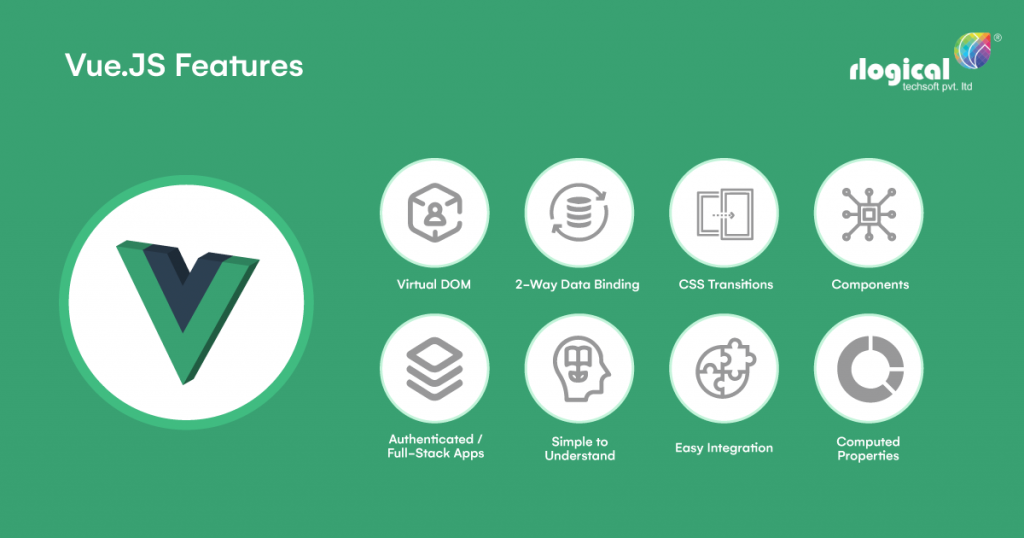Blog 19 - Vue.js
Vue.js: An Introduction
The open-source model view front-end known as Vue.js is a type of JavaScript framework that is used to build interfaces for users. It is also suitable for creating single-page applications. Vue.js has an architecture that emphasizes composition of components and declarative rendering, which is where an element can pull information to enable data rendering straight to the document object model. Features such as build tooling and state management can be added through various libraries and packages that are supported by Vue.js. This front-end JavaScript framework also offers HTML directives, which are attributes that can generate functionalities for applications. These can either come built-in with the latest version, or also be user defined. To learn more about Vue.js in this blog, we will be covering its versions/history, features and ecosystem.

History and Versions of Vue.js
Vue.js was created by Evan You, with the influence of another TypeScript-based web application (that I also covered a few blogs ago) known as Angular. The initial development began in mid of 2013, and the first release of Vue was in February 2014. According to Vue.js’s version histories, anytime a new major release is issued, the previous release will remain in LTS. This means they will still support bug fixes and other security patches for 18 months while users update to the latest version of Vue.js. An interesting note about Vue.js is that all the version names derive from manga and anime, which is a cool insider for programmers and developers that are into the science fiction genre.
The following include the 5 latest versions that were released for Vue.js
Quintessential Quintuplets:(3.2): Released on August 5,2021Pluto:(3.1): Released on June 7,2021One Piece:(3.0): Released on September 18,2020Macross:(2.6): Released on February 4,2019Level E:(2.5): Released on October 13,2017
Features
There are many features in Vue.js that are specialized into different classes. The first of these features are components, which essentially extend HTML elements. This is to encapsulate reusable code, and have components that are built with pre-defined options. Templates are features that used HTML-based templates to allow binding with instance data and the rendered document object model. Vue.JS compiles templates into virtual DOM functions, and this allows it to memory components before the browser updates. Reactivity is a feature that uses objects in plain JavaScript along with optimized re-rendering. Transitions are features that allow for ways to apply effects of transition during deletion, insertion and modification. This includes instances such as integrating third-party animation libraries, applying classes for CSS animations, and etc. Lastly, Routing is a feature which allows interface change based on the URL path, regardless of refresh or link redirection. This can also supported mapping for other nested components.

Ecosystem
The Vue.js ecosystem is based on tools and libraries that have either been developed by the core team, or have been added by contributors. The official tooling components include Devtools, and Vue CLI along with the Vue Loader. Official libraries that have been assisted by contributors include the Vue Router, Vuex, Vue Server Renderer, and Pinia.
Advantages and Disadvantages
Vue.js has its many advantages including its tiny size, which includes an 18kb downloadable zip file. The virtual Dom performance is also very impressive as Vue.js initializes a virtual DOM. This is essentially a copy of the original DOM, but does not require rendering the entire document object model for referencing. Other advantages of Vue.js include single-file components and readability, along with integration capabilities and flexibility. Its solid tooling ecosystem combined with an easy to learn model that is full of concise documentation is also a very important factor when listing the pros of Vue.js. Still, there are some disadvantages with Vue.js that programmers and developers have brought to the surface. Some of these disadvantages include reactivity complexity and a lack of support for projects that are of large-scale. There is also a risk of overly flexible features which might give the Dev team too many options that can result in a standstill when figuring out which to implement.
Learn More About Vue.js
To learn more about Vue.js visit their website, to navigate technical docs and introduce yourself with the Vue.js Playground and Ecosystem. The Vue.js Github Repository includes an introduction as well as the most essential elements needed to get Vue.js up and running. The Vue.js tutorials page also offers a fast way to start interactively learning Vue.js with their open terminal.
Stay tuned for a new blog post next week!